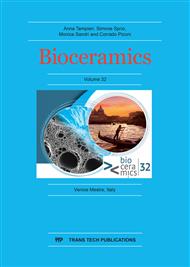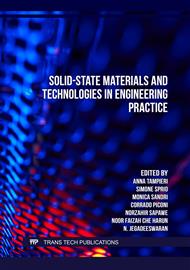[1]
V. Campana, G. Milano, E. Pagano, M. Barba, C. Cicione, G. Salonna, W. Lattanzi, G. Logroscino, Bone substitutes in orthopaedic surgery: from basic science to clinical practice, J. Mater. Sci. Mater. Med. 25 (2014) 2445–2461. https://doi.org/10.1007/s10856-014-5240-2.
DOI: 10.1007/s10856-014-5240-2
Google Scholar
[2]
W. Habraken, P. Habibovic, M. Epple, M. Bohner, Calcium phosphates in biomedical applications: materials for the future?, Mater. Today. 19 (2016) 69–87. https://doi.org/10.1016/j.mattod.2015.10.008.
DOI: 10.1016/j.mattod.2015.10.008
Google Scholar
[3]
R. Detsch, H. Mayr, G. Ziegler, Formation of osteoclast-like cells on HA and TCP ceramics, Acta Biomater. 4 (2008) 139–148. https://doi.org/10.1016/j.actbio.2007.03.014.
DOI: 10.1016/j.actbio.2007.03.014
Google Scholar
[4]
J. Barralet, M. Akao, H. Aoki, H. Aoki, Dissolution of dense carbonate apatite subcutaneously implanted in Wistar rats, J. Biomed. Mater. Res. 49 (2000) 176–182. https://doi.org/10.1002/(SICI)1097-4636(200002)49:2<176::AID-JBM4>3.0.CO;2-8.
DOI: 10.1002/(sici)1097-4636(200002)49:2<176::aid-jbm4>3.0.co;2-8
Google Scholar
[5]
A. Ogose, T. Hotta, H. Kawashima, N. Kondo, W. Gu, T. Kamura, N. Endo, Comparison of hydroxyapatite and beta tricalcium phosphate as bone substitutes after excision of bone tumors, J. Biomed. Mater. Res. B Appl. Biomater. 72 (2005) 94–101. https://doi.org/10.1002/jbm.b.30136.
DOI: 10.1002/jbm.b.30136
Google Scholar
[6]
G. Spence, N. Patel, R. Brooks, W. Bonfield, N. Rushton, Osteoclastogenesis on hydroxyapatite ceramics: the effect of carbonate substitution, J. Biomed. Mater. Res. A. 92 (2010) 1292–1300. https://doi.org/10.1002/jbm.a.32373.
DOI: 10.1002/jbm.a.32373
Google Scholar
[7]
R.Z. LeGeros, O.R. Trautz, E. Klein, J.P. LeGeros, Two types of carbonate substitution in the apatite structure, Experientia. 25 (1969) 5–7. https://doi.org/10.1007/BF01903856.
DOI: 10.1007/bf01903856
Google Scholar
[8]
M.E. Fleet, Carbonated Hydroxyapatite: Materials, Synthesis, and Applications, Jenny Stanford Publishing, New York, 2014. https://doi.org/10.1201/b17954.
Google Scholar
[9]
S.A. Redey, M. Nardin, D. Bernache-Assolant, C. Rey, P. Delannoy, L. Sedel, P.J. Marie, Behavior of human osteoblastic cells on stoichiometric hydroxyapatite and type A carbonate apatite: role of surface energy, J. Biomed. Mater. Res. 50 (2000) 353–364. https://doi.org/10.1002/(sici)1097-4636(20000605)50:3<353::aid-jbm9>3.0.co;2-c.
DOI: 10.1002/(sici)1097-4636(20000605)50:3<353::aid-jbm9>3.0.co;2-c
Google Scholar
[10]
B. Li, X. Liao, L. Zheng, H. He, H. Wang, H. Fan, X. Zhang, Preparation and cellular response of porous A-type carbonated hydroxyapatite nanoceramics, Mater. Sci. Eng. C. 32 (2012) 929–936. https://doi.org/10.1016/j.msec.2012.02.014.
DOI: 10.1016/j.msec.2012.02.014
Google Scholar
[11]
L.T. Bang, S. Ramesh, J. Purbolaksono, Y.C. Ching, B.D. Long, H. Chandran, S. Ramesh, R. Othman, Effects of silicate and carbonate substitution on the properties of hydroxyapatite prepared by aqueous co-precipitation method, Mater. Des. 87 (2015) 788–796. https://doi.org/10.1016/j.matdes.2015.08.069.
DOI: 10.1016/j.matdes.2015.08.069
Google Scholar
[12]
R.Z. LeGeros, R.Z. LeGeros, Calcium phosphates in oral biology and medicine, Karger, Basel, (1991).
Google Scholar
[13]
C. Rey, B. Collins, T. Goehl, I.R. Dickson, M.J. Glimcher, The carbonate environment in bone mineral: A resolution-enhanced fourier transform infrared spectroscopy study, Calcif. Tissue Int. 45 (1989) 157–164. https://doi.org/10.1007/BF02556059.
DOI: 10.1007/bf02556059
Google Scholar
[14]
A. Boyer, D. Marchat, D. Bernache-Assollant, Synthesis and Characterization of Cx-Siy-HA for Bone Tissue Engineering Application, Key Eng. Mater. (2013). https://doi.org/10.4028/www.scientific.net/KEM.529-530.100.
DOI: 10.4028/www.scientific.net/kem.529-530.100
Google Scholar
[15]
N. Douard, L. Leclerc, G. Sarry, V. Bin, D. Marchat, V. Forest, J. Pourchez, Impact of the chemical composition of poly-substituted hydroxyapatite particles on the in vitro pro-inflammatory response of macrophages, Biomed. Microdevices. 18 (2016) 27. https://doi.org/10.1007/s10544-016-0056-0.
DOI: 10.1007/s10544-016-0056-0
Google Scholar
[16]
E. Landi, G. Celotti, G. Logroscino, A. Tampieri, Carbonated hydroxyapatite as bone substitute, J. Eur. Ceram. Soc. 23 (2003) 2931–2937. https://doi.org/10.1016/S0955-2219(03)00304-2.
DOI: 10.1016/s0955-2219(03)00304-2
Google Scholar
[17]
J.P. Lafon, E. Champion, D. Bernache-Assollant, Processing of AB-type carbonated hydroxyapatite Ca10−x(PO4)6−x(CO3)x(OH)2−x−2y(CO3)y ceramics with controlled composition, J. Eur. Ceram. Soc. 28 (2008) 139–147. https://doi.org/10.1016/j.jeurceramsoc. 2007.06.009.
DOI: 10.1016/j.jeurceramsoc.2007.06.009
Google Scholar
[18]
M. Safarzadeh, C.F. Chee, S. Ramesh, M.N.A. Fauzi, Effect of sintering temperature on the morphology, crystallinity and mechanical properties of carbonated hydroxyapatite (CHA), Ceram. Int. 46 (2020) 26784–26789. https://doi.org/10.1016/j.ceramint.2020.07.153.
DOI: 10.1016/j.ceramint.2020.07.153
Google Scholar
[19]
Z. Zyman, M. Tkachenko, CO2 gas-activated sintering of carbonated hydroxyapatites, J. Eur. Ceram. Soc. 31 (2011) 241–248. https://doi.org/10.1016/j.jeurceramsoc.2010.09.005.
DOI: 10.1016/j.jeurceramsoc.2010.09.005
Google Scholar
[20]
D.K. Agrawal, Microwave processing of ceramics, Curr. Opin. Solid State Mater. Sci. 3 (1998) 480–485. https://doi.org/10.1016/S1359-0286(98)80011-9.
Google Scholar
[21]
M. Oghbaei, O. Mirzaee, Microwave versus conventional sintering: A review of fundamentals, advantages and applications, J. Alloys Compd. 494 (2010) 175–189. https://doi.org/10.1016/j.jallcom.2010.01.068.
DOI: 10.1016/j.jallcom.2010.01.068
Google Scholar
[22]
P. Sikder, Y. Ren, S.B. Bhaduri, Microwave processing of calcium phosphate and magnesium phosphate based orthopedic bioceramics: A state-of-the-art review, Acta Biomater. 111 (2020) 29–53. https://doi.org/10.1016/j.actbio.2020.05.018.
DOI: 10.1016/j.actbio.2020.05.018
Google Scholar
[23]
N. Somers, F. Jean, M. Lasgorceix, H. Curto, G. Urruth, A. Thuault, F. Petit, A. Leriche, Influence of dopants on thermal stability and densification of β-tricalcium phosphate powders, Open Ceram. 7 (2021) 100168. https://doi.org/10.1016/j.oceram.2021.100168.
DOI: 10.1016/j.oceram.2021.100168
Google Scholar
[24]
Y. Fang, D.K. Agrawal, D.M. Roy, R. Roy, Fabrication of porous hydroxyapatite ceramics by microwave processing, J. Mater. Res. 7 (1992) 490–494. https://doi.org/10.1557/JMR. 1992.0490.
DOI: 10.1557/jmr.1992.0490
Google Scholar
[25]
Y. Fang, D.K. Agrawal, D.M. Roy, R. Roy, Microwave sintering of hydroxyapatite ceramics, J. Mater. Res. 9 (1994) 180–187. https://doi.org/10.1557/JMR.1994.0180.
DOI: 10.1557/jmr.1994.0180
Google Scholar
[26]
A. Chanda, S. Dasgupta, S. Bose, A. Bandyopadhyay, Microwave sintering of calcium phosphate ceramics, Mater. Sci. Eng. C. 29 (2009) 1144–1149. https://doi.org/10.1016/j.msec. 2008.09.008.
DOI: 10.1016/j.msec.2008.09.008
Google Scholar
[27]
M.G. Kutty, S.B. Bhaduri, H. Zhou, A. Yaghoubi, In situ measurement of shrinkage and temperature profile in microwave- and conventionally-sintered hydroxyapatite bioceramic, Mater. Lett. 161 (2015) 375–378. https://doi.org/10.1016/j.matlet.2015.08.136.
DOI: 10.1016/j.matlet.2015.08.136
Google Scholar
[28]
B. Li, X. Chen, B. Guo, X. Wang, H. Fan, X. Zhang, Fabrication and cellular biocompatibility of porous carbonated biphasic calcium phosphate ceramics with a nanostructure, Acta Biomater. 5 (2009) 134–143. https://doi.org/10.1016/j.actbio.2008.07.035.
DOI: 10.1016/j.actbio.2008.07.035
Google Scholar
[29]
N. Khalile, C. Petit, C. Meunier, F. Valdivieso, Hybrid microwave sintering of alumina and 3 mol% Y2O3-stabilized zirconia in a multimode cavity – Influence of the sintering cell, Ceram. Int. (2022). https://doi.org/10.1016/j.ceramint.2022.03.072.
DOI: 10.1016/j.ceramint.2022.03.072
Google Scholar
[30]
R. Macaigne, S. Marinel, D. Goeuriot, C. Meunier, S. Saunier, G. Riquet, Microwave sintering of pure and TiO2 doped MgAl2O4 ceramic using calibrated, contactless in-situ dilatometry, Ceram. Int. 42 (2016) 16997–17003. https://doi.org/10.1016/j.ceramint.2016.07.206.
DOI: 10.1016/j.ceramint.2016.07.206
Google Scholar
[31]
J. Croquesel, D. Bouvard, J.-M. Chaix, C.P. Carry, S. Saunier, Development of an instrumented and automated single mode cavity for ceramic microwave sintering: Application to an alpha pure alumina powder, Mater. Des. 88 (2015) 98–105. https://doi.org/10.1016/j.matdes. 2015.08.122.
DOI: 10.1016/j.matdes.2015.08.122
Google Scholar
[32]
X.-Y. Liu, M. Huang, H.-L. Ma, Z.-Q. Zhang, J.-M. Gao, Y.-L. Zhu, X.-J. Han, X.-Y. Guo, Preparation of a Carbon-Based Solid Acid Catalyst by Sulfonating Activated Carbon in a Chemical Reduction Process, Molecules. 15 (2010) 7188–7196. https://doi.org/10.3390/molecules15107188.
DOI: 10.3390/molecules15107188
Google Scholar
[33]
C.F. Ramirez-Gutierrez, R. Arias-Niquepa, J.J. Prías-Barragán, M.E. Rodriguez-Garcia, Study and identification of contaminant phases in commercial activated carbons, J. Environ. Chem. Eng. 8 (2020) 103636. https://doi.org/10.1016/j.jece.2019.103636.
DOI: 10.1016/j.jece.2019.103636
Google Scholar
[34]
C. Rey, V. Renugopalakrishman, B. Collins, M.J. Glimcher, Fourier transform infrared spectroscopic study of the carbonate ions in bone mineral during aging, Calcif. Tissue Int. 49 (1991) 251–258. https://doi.org/10.1007/BF02556214.
DOI: 10.1007/bf02556214
Google Scholar
[35]
A. Paré, B. Charbonnier, P. Tournier, C. Vignes, J. Veziers, J. Lesoeur, B. Laure, H. Bertin, G. De Pinieux, G. Cherrier, J. Guicheux, O. Gauthier, P. Corre, D. Marchat, P. Weiss, Tailored Three-Dimensionally Printed Triply Periodic Calcium Phosphate Implants: A Preclinical Study for Craniofacial Bone Repair, ACS Biomater. Sci. Eng. 6 (2020) 553–563. https://doi.org/10.1021/acsbiomaterials.9b01241.
DOI: 10.1021/acsbiomaterials.9b01241
Google Scholar
[36]
J.-C. Labarthe, G. Bonel, G. Montel, Sur la structure et les propriétés des apatites carbonatées de type B phospho-calciques., Ann. Chim. 8 (1973) 289–301.
Google Scholar
[37]
J.P. Lafon, E. Champion, D. Bernache-Assollant, R. Gibert, A.M. Danna, Termal decomposition of carbonated calcium phosphate apatites, J. Therm. Anal. Calorim. 72 (2003) 1127–1134. https://doi.org/10.1023/A:1025036214044.
DOI: 10.1023/a:1025036214044
Google Scholar
[38]
A. Boyer, Synthèse, caractérisation et évaluation biologique d'apatites phosphocalciques carbo silicatées, thesis, Saint-Etienne, EMSE, 2014. http://www.theses.fr/2014EMSE0739 (accessed March 16, 2020).
Google Scholar
[39]
R.R. Mishra, A.K. Sharma, Microwave–material interaction phenomena: Heating mechanisms, challenges and opportunities in material processing, Compos. Part Appl. Sci. Manuf. 81 (2016) 78–97. https://doi.org/10.1016/j.compositesa.2015.10.035.
DOI: 10.1016/j.compositesa.2015.10.035
Google Scholar
[40]
J.A. Menéndez, A. Arenillas, B. Fidalgo, Y. Fernández, L. Zubizarreta, E.G. Calvo, J.M. Bermúdez, Microwave heating processes involving carbon materials, Fuel Process. Technol. 91 (2010) 1–8. https://doi.org/10.1016/j.fuproc.2009.08.021.
DOI: 10.1016/j.fuproc.2009.08.021
Google Scholar
[41]
W. Lerdprom, E. Zapata-Solvas, D.D. Jayaseelan, A. Borrell, M.D. Salvador, W.E. Lee, Impact of microwave processing on porcelain microstructure, Ceram. Int. 43 (2017) 13765–13771. https://doi.org/10.1016/j.ceramint.2017.07.090.
DOI: 10.1016/j.ceramint.2017.07.090
Google Scholar
[42]
T. Santos, L. Hennetier, V.A.F. Costa, L.C. Costa, Microwave versus conventional porcelain firing: Temperature measurement, J. Manuf. Process. 41 (2019) 92–100. https://doi.org/10.1016/j.jmapro.2019.03.038.
DOI: 10.1016/j.jmapro.2019.03.038
Google Scholar
[43]
D. Żymełka, S. Saunier, J. Molimard, D. Goeuriot, Contactless Monitoring of Shrinkage and Temperature Distribution during Hybrid Microwave Sintering, Adv. Eng. Mater. 13 (2011) 901–905. https://doi.org/10.1002/adem.201000354.
DOI: 10.1002/adem.201000354
Google Scholar
[44]
F. Zuo, S. Saunier, S. Marinel, P. Chanin-Lambert, N. Peillon, D. Goeuriot, Investigation of the mechanism(s) controlling microwave sintering of α-alumina: Influence of the powder parameters on the grain growth, thermodynamics and densification kinetics, J. Eur. Ceram. Soc. 35 (2015) 959–970. https://doi.org/10.1016/j.jeurceramsoc.2014.10.025.
DOI: 10.1016/j.jeurceramsoc.2014.10.025
Google Scholar



